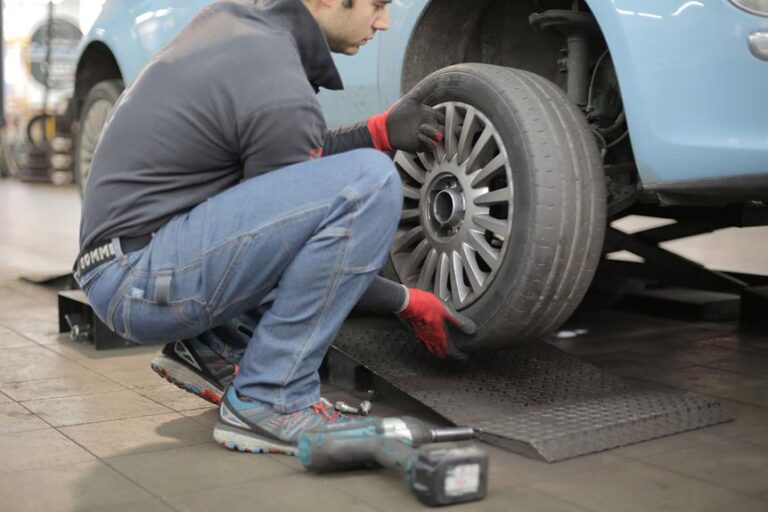Pirelli Tire Selection Guide: Performance Matters
Like a finely-tuned instrument, the right performance tires can elevate your driving experience to new heights. In this comprehensive guide, we delve into the importance of performance in tire selection and provide valuable insights into the factors to consider when choosing the perfect set of Pirelli tires.
With Pirelli's cutting-edge performance tire technologies, we explore how to match your driving style and navigate different weather conditions, ultimately enhancing your vehicle's performance and ensuring your safety on the road.
Key Takeaways
- Performance aspect in tire selection ensures optimal safety and efficiency on the road.
- High-performance tires offer improved traction and grip on both dry and wet surfaces.
- Regular inspection and rotation of performance tires ensure even wear and extend their lifespan.
- Pirelli's performance tire technologies, such as advanced compound formulations and innovative tread patterns, enhance handling, stability, and fuel efficiency.
The Importance of Performance in Tire Selection
Regularly evaluating and prioritizing the performance aspect in tire selection is crucial for ensuring optimal safety and efficiency on the road. When it comes to tires, performance is not just about speed or handling; it encompasses a wide range of factors that contribute to a better driving experience.
One of the key benefits of choosing high-performance tires is improved traction. These tires are designed with advanced tread patterns and rubber compounds that offer superior grip on both dry and wet surfaces. This means better control and stability, especially during cornering and braking. Additionally, performance tires often have a shorter braking distance, allowing drivers to stop more quickly and avoid potential accidents.
Another important aspect of performance tire maintenance is regular inspection and rotation. This helps to ensure even wear and extend the lifespan of the tires. Additionally, maintaining the correct tire pressure is essential for optimal performance. Underinflated tires can negatively impact handling and fuel efficiency, while overinflated tires can lead to premature wear and decreased traction. Regularly checking and adjusting tire pressure can greatly enhance the performance and longevity of the tires.
Factors to Consider When Choosing Performance Tires
When choosing performance tires, it is important to consider factors such as weather and road conditions, as well as handling and grip.
Performance tires are designed to provide optimal traction and control in various driving situations, so it is crucial to select tires that are suited to the specific conditions you will be driving in.
Additionally, considering the tire's handling capabilities and grip levels can greatly enhance your vehicle's overall performance and safety.
Weather and Road Conditions
Given the unpredictable nature of weather and road conditions, it is crucial to select performance tires that can effectively handle varying levels of traction and grip. In order to ensure optimal performance, it is important to consider factors such as tire pressure and tire maintenance.
Maintaining the correct tire pressure is essential for maximizing grip and handling. Underinflated tires can lead to decreased traction and increased braking distances, while overinflated tires can result in reduced contact with the road surface, leading to compromised control.
Regular tire maintenance, including checking for wear and tear, alignment, and rotation, is also vital for maintaining optimal performance and safety. By properly maintaining and selecting performance tires, drivers can enhance their vehicles' handling and grip, providing a safer and more enjoyable driving experience.
Handling and Grip
How do factors such as tread pattern and rubber compound affect the handling and grip of performance tires?
Tire performance is greatly influenced by tread pattern and rubber compound. The tread pattern determines how the tire interacts with the road surface, affecting handling and grip. A wide, aggressive tread pattern with deep grooves is ideal for performance tires as it provides maximum traction and grip, especially in wet conditions. On the other hand, a tread pattern with less aggressive grooves may offer better handling and stability at high speeds.
Additionally, the rubber compound used in performance tires plays a crucial role in grip. Softer compounds provide better grip but wear out faster, while harder compounds offer durability but compromise on grip.
Pirelli's performance tire technologies further enhance handling and grip, ensuring optimal performance on the road.
Pirelli's performance tire technologies incorporate advanced tread designs and innovative rubber compounds to deliver superior handling and grip.
Pirelli's Performance Tire Technologies
One must consider Pirelli's innovative performance tire technologies when seeking optimal traction and handling capabilities. Pirelli has long been at the forefront of tire performance innovations, constantly pushing the boundaries of what is possible. Their advanced tire technology has been developed through years of research and development, resulting in tires that offer exceptional performance in various driving conditions.
Here are five key features of Pirelli's performance tire technologies:
- High-performance compounds: Pirelli utilizes advanced compound formulations that provide excellent grip and traction on both dry and wet surfaces.
- Innovative tread patterns: Pirelli's tire designs incorporate unique tread patterns that optimize contact with the road, enhancing handling and stability.
- Enhanced sidewall construction: Pirelli's tires feature reinforced sidewalls, improving cornering stability and overall responsiveness.
- Noise reduction technology: Pirelli has developed innovative technologies that minimize tire noise, ensuring a quiet and comfortable driving experience.
- Advanced tire construction: Pirelli's tires are engineered with advanced construction techniques, resulting in a lightweight yet durable tire that maximizes performance and fuel efficiency.
With Pirelli's tire performance innovations, drivers can experience the freedom of superior traction and handling capabilities, allowing them to confidently navigate any road or track with precision and control.
Understanding Tire Performance Ratings
To fully comprehend the capabilities of Pirelli's performance tires, it is crucial for drivers to have a comprehensive understanding of tire performance ratings. These ratings serve as tire performance indicators, providing valuable information about various aspects of tire performance, such as traction, temperature resistance, and treadwear. By understanding these ratings, drivers can make informed decisions when selecting the right performance tires for their vehicles.
Tire performance ratings are typically represented by a combination of letters and numbers. The most common performance rating system is the Uniform Tire Quality Grading (UTQG), which is used to assess traction, temperature resistance, and treadwear. The traction rating indicates a tire's ability to stop on wet surfaces, while the temperature rating measures the tire's resistance to heat buildup. The treadwear rating indicates the tire's expected lifespan.
In addition to the UTQG ratings, there are other performance indicators to consider, such as the speed rating, which indicates the maximum speed a tire can safely handle, and the load rating, which indicates the maximum weight a tire can support. These ratings vary depending on the specific tire model and size.
How to Match Your Driving Style With the Right Performance Tires
To match your driving style with the right performance tires, it is important to consider the impact your driving style has on tire performance.
Factors such as speed, cornering, and braking habits can significantly affect tire wear and grip.
Driving Style Impact
The driving style impact on tire performance is a crucial factor to consider when selecting the right set of tires for your vehicle. Different driving habits can have varying effects on tire longevity and overall performance. Here are five key points to keep in mind:
- Aggressive driving: Frequent hard acceleration, braking, and high-speed cornering can lead to faster tire wear and reduced longevity.
- Eco-friendly driving: Gentle acceleration, braking, and maintaining a steady speed can help prolong tire life and improve fuel efficiency.
- Off-road driving: Rough terrains and uneven surfaces can cause increased wear and tear on tires, requiring more durable and rugged options.
- City driving: Frequent stop-and-go traffic can lead to increased tire wear, requiring tires with good traction and braking capabilities.
- Highway driving: Long-distance driving at high speeds can cause tire heat buildup and increased tire wear, necessitating tires with excellent heat dissipation and longevity.
Considering your driving style and selecting the appropriate tires can help maximize tire longevity and ensure optimal performance on the road.
Choosing the Right Tires
I highly recommend considering your driving style when choosing the right tires for your vehicle to ensure optimal performance and longevity. Different driving styles require different tire characteristics to provide the best handling, traction, and durability. To help you make an informed decision, here is a comparison table of three popular tire types:
| Tire Type | Performance | Longevity |
|---|---|---|
| All-Season | Versatile | Moderate |
| Performance | Excellent traction | Decreased lifespan |
| Off-Road | Enhanced traction | Reduced lifespan |
It is important to note that tire maintenance plays a significant role in extending their lifespan. Regularly checking tire pressure, rotating tires, and aligning the wheels can help maximize their durability. Additionally, driving habits such as avoiding sudden acceleration or hard braking can also contribute to prolonged tire life. Ultimately, selecting the right tires and practicing proper maintenance will ensure a smooth and safe driving experience while also maximizing tire lifespan.
Performance Vs. Safety
Are performance tires more suitable for drivers who prioritize speed, or should safety take precedence when selecting tires?
- Performance tires are designed for drivers who prioritize speed and handling.
- Safety should always be a top priority when selecting tires.
Performance tires offer better traction and grip, allowing for more precise control and maneuverability. However, performance tires may have shorter tread life compared to regular tires. Performance tires also tend to have lower fuel efficiency due to their stickier rubber compounds.
When it comes to the debate between performance and safety, it is important to find the right balance. While performance tires can enhance the driving experience, they may compromise safety in certain situations. It is crucial to consider factors such as driving conditions, weather, and personal driving habits before making a decision.
Ultimately, it is up to the individual driver to prioritize their needs and preferences when selecting tires.
Performance Tires for Different Weather Conditions
When considering performance tires for different weather conditions, drivers must be mindful of the varying demands imposed by rain, snow, or dry road surfaces. Different types of performance tires are designed to optimize performance and safety in specific weather conditions. For example, winter performance tires are specifically engineered to provide maximum traction and control on icy and snowy roads. These tires have deeper treads and special rubber compounds that remain flexible in low temperatures, ensuring better grip. On the other hand, summer performance tires are designed to excel in hot and dry conditions. They have shallower treads and a harder rubber compound, which enhances grip and stability on dry roads. To help drivers make informed decisions, the table below provides a comparison of winter performance tires and summer performance tires:
| Winter Performance Tires | Summer Performance Tires |
|---|---|
| Deeper treads | Shallower treads |
| Special rubber compound | Harder rubber compound |
| Flexibility in low temperatures | Enhanced grip and stability on dry roads |
Enhancing Performance and Safety With Pirelli Tires
- Pirelli tires are designed with advanced technology and high-quality materials to optimize performance and safety on the road. The tread patterns of Pirelli tires are carefully engineered to maximize traction and grip, ensuring better handling and control in various driving conditions. Pirelli tires are known for their excellent braking capabilities, allowing drivers to stop safely and quickly when needed.
- The construction of Pirelli tires is designed to provide stability and reduce rolling resistance, resulting in improved fuel efficiency and reduced carbon emissions. Pirelli tires undergo rigorous testing and quality control processes to ensure their durability and reliability, giving drivers peace of mind on the road.
Pirelli understands the importance of performance and safety for drivers who desire freedom on the road. With their commitment to innovation and excellence, Pirelli tires offer enhanced performance, improved handling, and increased safety. Whether you are looking for tires to enhance your vehicle's performance on the track or to provide a smooth and safe ride on the highway, Pirelli offers a wide range of tire options to meet your needs.
Frequently Asked Questions
What Is the Recommended Tire Pressure for Pirelli Performance Tires?
Tire pressure recommendations for Pirelli performance tires can vary depending on the specific model and vehicle. It is crucial to consult the manufacturer's guidelines or a trusted professional to ensure optimal performance and safety. Performance tires offer advantages such as enhanced grip, handling, and responsiveness.
Can Performance Tires Be Used Year-Round, or Should They Be Switched Out for Winter Tires?
Performance tires can provide excellent grip and handling in dry and wet conditions, but they are not designed for winter driving. Winter tires offer better traction on ice and snow, making them a safer choice for winter driving.
Are Pirelli Performance Tires Suitable for Off-Road Driving?
Pirelli performance tires are designed for optimal performance on various terrains, making them suitable for off-road driving. These tires offer enhanced traction, durability, and stability, providing drivers with the advantage they need in different off-road conditions.
How Often Should Performance Tires Be Rotated and Balanced?
Performance tire maintenance is crucial for optimal performance and safety. Regular rotation and balancing of performance tires help ensure even wear, improve handling, and extend tire life. It is generally recommended to rotate and balance performance tires every 5,000-7,500 miles or as instructed by the tire manufacturer.
What Is the Expected Lifespan of Pirelli Performance Tires?
The expected lifespan of Pirelli performance tires is influenced by various factors such as driving habits, road conditions, and maintenance. Regularly checking and maintaining proper tire pressure can help maximize their lifespan.
Conclusion
In conclusion, when selecting tires, considering performance is crucial for enhancing safety and optimizing driving experience.
Pirelli offers a range of performance tire technologies designed to match different driving styles and weather conditions.
Understanding tire performance ratings can help in making informed decisions.
One interesting statistic to note is that according to a study, properly selected performance tires can reduce stopping distance by up to 30%, highlighting the significant impact they can have on road safety.







